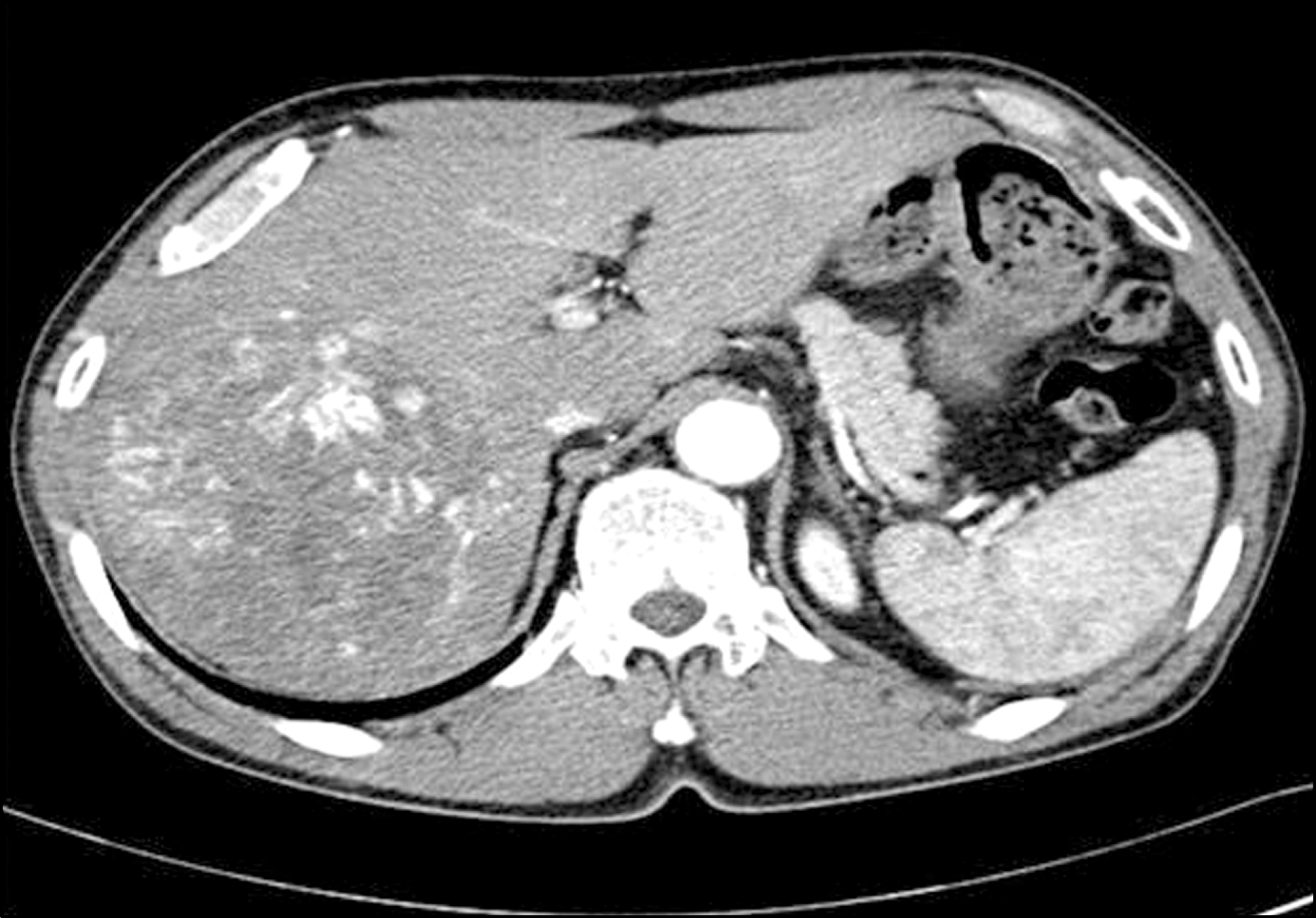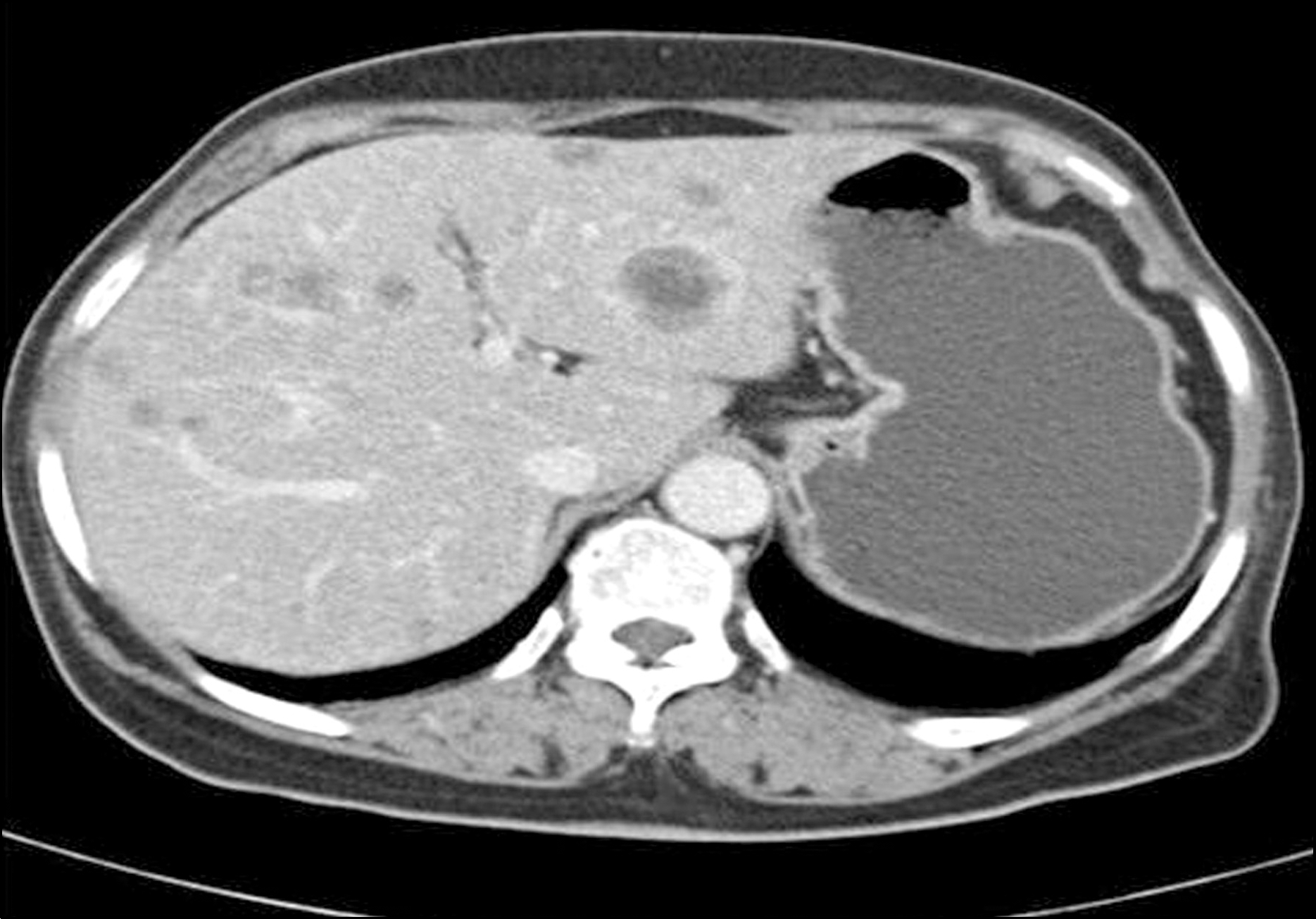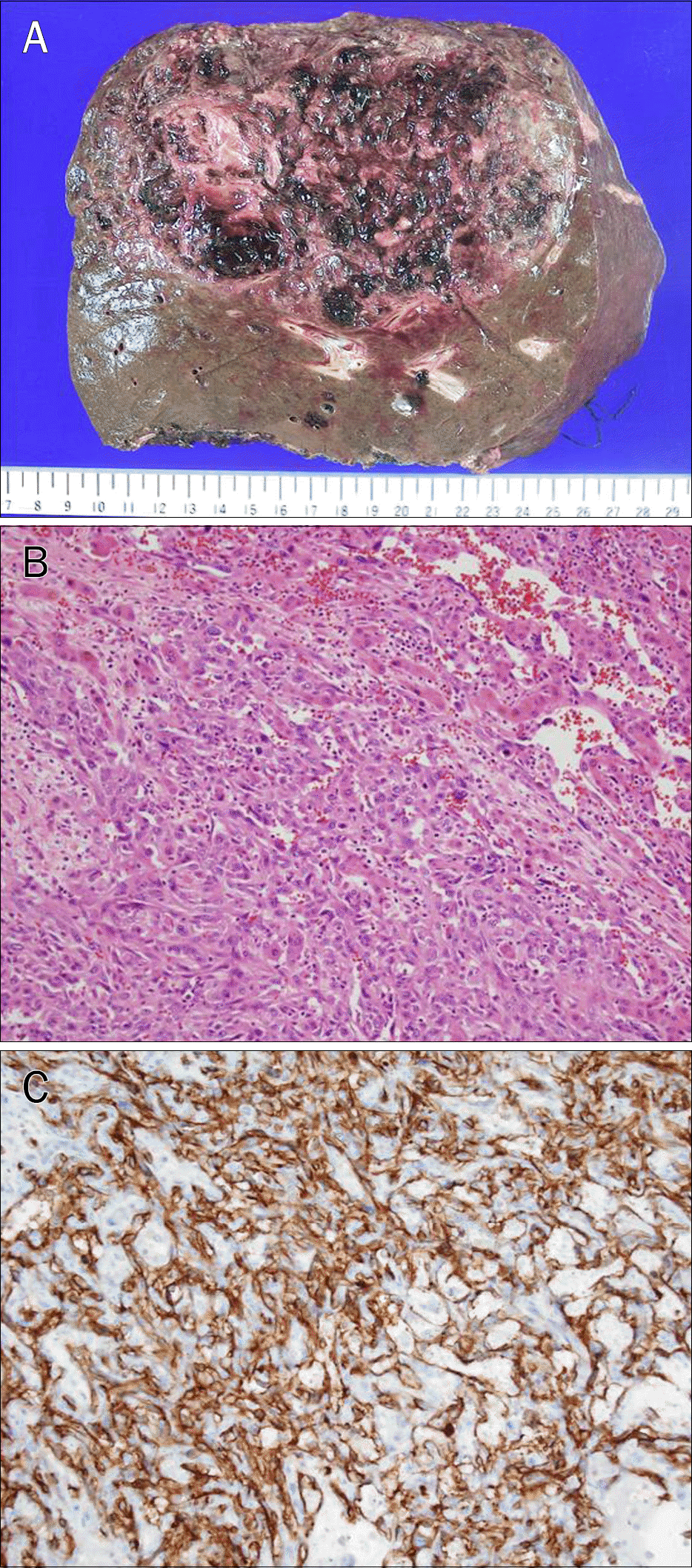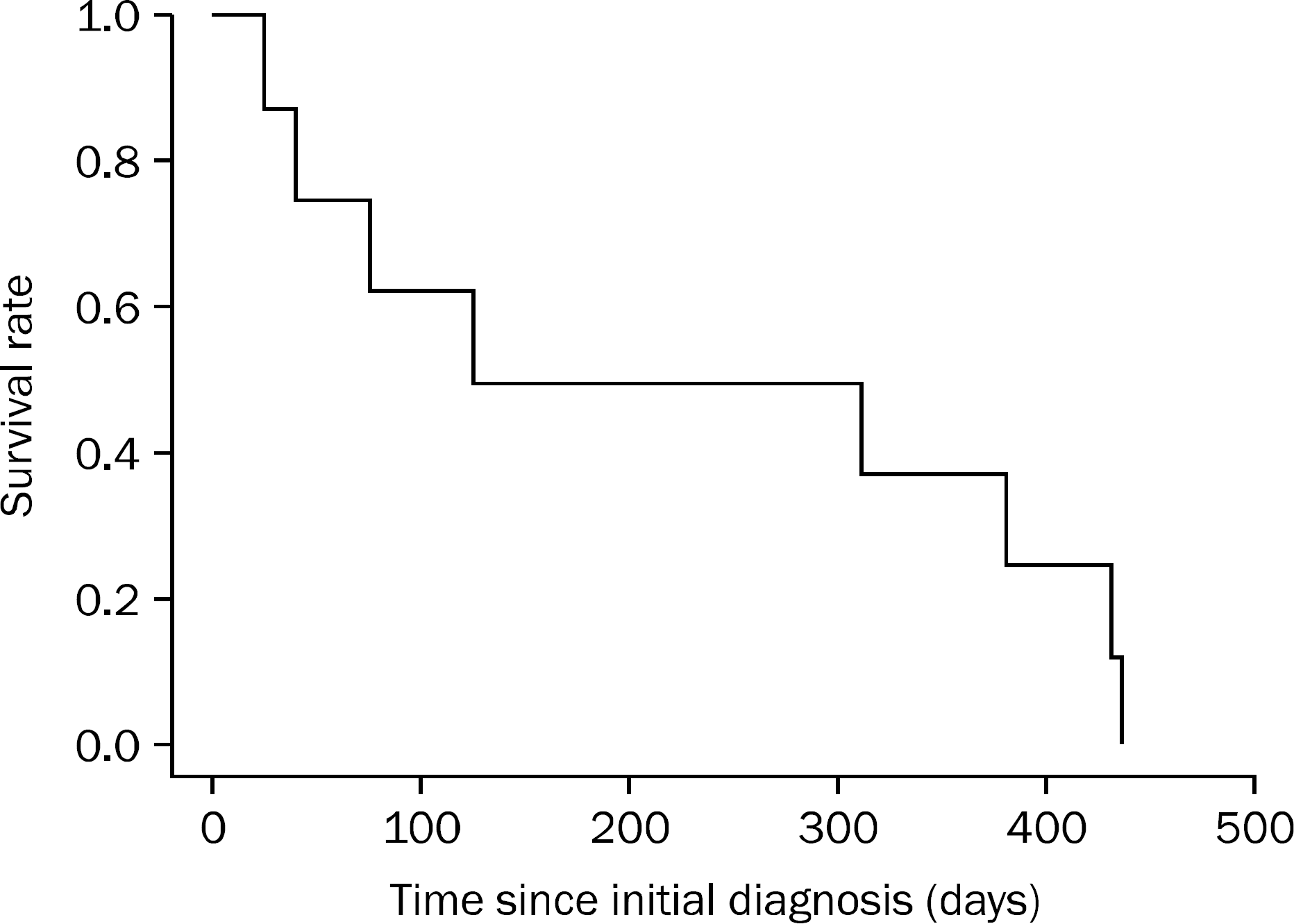Abstract
Background/Aims
Hepatic angiosarcoma, a rare and aggressive liver malignancy, is difficult to diagnose because of a lack of specific clinical features. The clinical and radiological features of patients with histologically confirmed hepatic angiosarcoma were examined.
Methods
Among 2,336 patients diagnosed with primary hepatic carcinoma at Keimyung University Dongsan Medical Center (Daegu, Korea) between May 2002 and February 2012, eight (0.03%) with histologically confirmed primary hepatic angiosarcoma were included. The patterns of disease diagnosis, tumor characteristics, treatment responses, and prognoses were reviewed retrospectively.
Results
Median age was 66 years-old (range, 41–80 years). Four patients were male. Five patients were compulsive drinkers. All patients had no HBsAg and anti-HCV. Initial radiologic diagnoses revealed primary hepatic angiosarcoma (n=2), hepatocellular carcinoma (n=2), hemangioma (n=2), and hepatic metastatic carcinoma (n=2). Definitive diagnoses were made by percutaneous needle biopsies in seven patients and surgical resection in one patient. At the time of the initial diagnosis, extrahepatic metastases were detected in three patients (37.5%). Metastatic sites included the spleen and lung, pericardium, and bone, in one patient each. Two patients underwent conservative treatments. The remaining patients underwent surgical resection (n=1), transcatheter arterial chemoembolization (n=1), and systemic chemotherapy (n=4). The median survival period was 214 days (range, 21–431 days).
References
1. Molina E, Hernandez A. Clinical manifestations of primary hepatic angiosarcoma. Dig Dis Sci. 2003; 48:677–682.
2. Oe A, Habu D, Kawabe J, et al. A case of diffuse hepatic angiosarcoma diagnosed by FDG-PET. Ann Nucl Med. 2005; 19:519–521.

3. Locker GY, Doroshow JH, Zwelling LA, Chabner BA. The clinical features of hepatic angiosarcoma: a report of four cases and a review of the English literature. Medicine (Baltimore). 1979; 58:48–64.

4. Bioulac-Sage P, Laumonier H, Laurent C, Blanc JF, Balabaud C. Benign and malignant vascular tumors of the liver in adults. Semin Liver Dis. 2008; 28:302–314.

5. Almogy G, Lieberman S, Gips M, et al. Clinical outcomes of surgical resections for primary liver sarcoma in adults: results from a single centre. Eur J Surg Oncol. 2004; 30:421–427.

6. Holden CA, Spittle MF, Jones EW. Angiosarcoma of the face and scalp, prognosis and treatment. Cancer. 1987; 59:1046–1057.

7. Maddox JC, Evans HL. Angiosarcoma of skin and soft tissue: a study of forty-four cases. Cancer. 1981; 48:1907–1921.

8. Timaran CH, Grandas OH, Bell JL. Hepatic angiosarcoma: long-term survival after complete surgical removal. Am Surg. 2000; 66:1153–1157.
9. Ozden I, Bilge O, Erkan M, Cevikbaş U, Acarli K. Five years and 4 months of recurrence-free survival in hepatic angiosarcoma. J Hepatobiliary Pancreat Surg. 2003; 10:250–252.
10. Arima-Iwasa S, Chijiiwa K, Makino I, Tanabe R, Ohuchida J, Kondo K. A case of hepatic angiosarcoma surviving for more than 16 months after hepatic resection. Hepatogastroenter-ology. 2007; 54:533–535.
11. Zhou YM, Li B, Yin ZM, et al. Results of hepatic resection for primary hepatic angiosarcoma in adults. Med Sci Monit. 2010; 16:CR61–CR66.
12. Louagie YA, Gianello P, Kestens PJ, Bonbled F, Haot JG. Vinylchloride induced hepatic angiosarcoma. Br J Surg. 1984; 71:322–323.

13. Ludwig J, Hoffman HN. Hemangiosarcoma of the liver. Spectrum of morphologic changes and clinical findings. Mayo Clin Proc. 1975; 50:255–263.
14. Kojiro M, Nakashima T, Ito Y, Ikezaki H, Mori T, Kido C. Thorium dioxide-related angiosarcoma of the liver. Pathomorphologic study of 29 autopsy cases. Arch Pathol Lab Med. 1985; 109:853–857.
15. Koyama T, Fletcher JG, Johnson CD, Kuo MS, Notohara K, Burgart LJ. Primary hepatic angiosarcoma: findings at CT and MR imaging. Radiology. 2002; 222:667–673.

16. Fayette J, Martin E, Piperno-Neumann S, et al. Angiosarcomas, a heterogeneous group of sarcomas with specific behavior de-pending on primary site: a retrospective study of 161 cases. Ann Oncol. 2007; 18:2030–2036.

17. Alrenga DP. Primary angiosarcoma of the liver. Review article. Int Surg. 1975; 60:198–203.
18. Park YS, Kim JH, Kim KW, et al. Primary hepatic angiosarcoma: imaging findings and palliative treatment with transcatheter arterial chemoembolization or embolization. Clin Radiol. 2009; 64:779–785.

19. Buetow PC, Buck JL, Ros PR, Goodman ZD. Malignant vascular tumors of the liver: radiologic-pathologic correlation. Radio-graphics. 1994; 14:153–166.

20. White PG, Adams H, Smith PM. The computed tomographic ap-pearances of angiosarcoma of the liver. Clin Radiol. 1993; 48:321–325.

21. Yang KF, Leow VM, Hasnan MN, Manisekar KS. Primary hepatic angiosarcoma: difficulty in clinical, radiological, and pathological diagnosis. Med J Malaysia. 2012; 67:127–128.
22. Heo SH, Jeong YY, Shin SS, Chung TW, Kang HK. Solitary small hepatic angiosarcoma: initial and follow-up imaging findings. Korean J Radiol. 2007; 8:180–183.

23. Drinković I, Brkljacić B. Two cases of lethal complications following ultrasound-guided percutaneous fine-needle biopsy of the liver. Cardiovasc Intervent Radiol. 1996; 19:360–363.

24. Peterson MS, Baron RL, Rankin SC. Hepatic angiosarcoma: findings on multiphasic contrast-enhanced helical CT do not mimic hepatic hemangioma. AJR Am J Roentgenol. 2000; 175:165–70.
25. Hertzanu Y, Peiser J, Zirkin H. Massive bleeding after fine needle aspiration of liver angiosarcoma. Gastrointest Radiol. 1990; 15:43–46.

27. Mark RJ, Poen JC, Tran LM, Fu YS, Juillard GF. Angiosarcoma. A report of 67 patients and a review of the literature. Cancer. 1996; 77:2400–2406.

Fig. 1.
CT findings of a typical hepatic angiosarcoma. A huge hypervascular enhancing mass with a central necrotic portion can be seen in the right hepatic lobe. Most nodular lesions are hypoattenuated and have enhanced foci. The enhancement is less than that of aorta, and some nodular lesions show irregular or ring enhancement. A progressive enhancement pattern can be seen in the delayed phase CT.

Fig. 2.
CT findings of an atypical hepatic angiosarcoma. Multiple peripheral enhancing nodules with a hypoattenuated center are scattered in the liver.

Fig. 3.
Cut surface and microscopic findings of the liver. (A) Surgically resected right lobe, measuring up to 14.0×11.5×5.5 cm, showed an ill-defined large heterogeneous hepatic mass with solid, cystic nature. Diffusely scattered areas of hemorrhage and necrosis were seen in the mass. (B) Needle biopsy of the hepatic mass showed diffuse growth of pleomorphic hyperchromatic tumor cells with anastomosing vascular channels (H&E, ×200). (C) Immunohistochemical staining for CD31 showed diffuse, strong, positive reactivity in the atypical tumor cells (×200), demonstrating a vascular-type tumor originating from endothelial cells.

Fig. 4.
Survival time of the hepatic angiosarcoma patients. The median survival period was 214 days (range, 21–431 days).

Table 1.
Characteristics of Patients and Clinical Findings with Primary Hepatic Angiosarcoma




 PDF
PDF ePub
ePub Citation
Citation Print
Print


 XML Download
XML Download